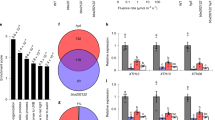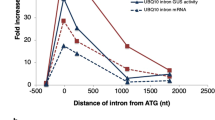Abstract
Studies in viral and mammalian cell systems have identified regulatory elements, collectively termed enhancers, which are cis-acting elements effective in either orientation and at both 5′ and 3′ ends of a gene, and which increase transcription when linked to either their own or a heterologous promoter gene system1–5. Certain upstream elements in yeast have also been shown to exert a negative effect on the rate of transcription of cell-cycle-specific genes and these have been called silencers6. Two of the best characterized plant gene families are those of the small subunit of the ribulose 1,5-bisphosphate carboxylase (rbcS) genes7 and the lightharvesting chlorophyll a/b-bind ing protein (lhcp) genes8. The first enhancer element in plants has recently been described showing that an upstream element of an rbcS gene could, in both orientations, confer light-inducible expression on a heterologous promoter/gene system9. We report here that a 247-base pair (bp) element from an lhcp gene acts not only as a light-inducible enhancer but also as a tissue-specific ‘silencer’.
This is a preview of subscription content, access via your institution
Access options
Subscribe to this journal
Receive 51 print issues and online access
$199.00 per year
only $3.90 per issue
Buy this article
- Purchase on Springer Link
- Instant access to full article PDF
Prices may be subject to local taxes which are calculated during checkout
Similar content being viewed by others
References
Banerji, J., Rusconi, S. & Schaffner, W. Cell 27, 299–308 (1981).
Moreau, P. et al. Nucleic Acids Res. 9, 6047–6068 (1981).
Fromm, M. & Berg, P. Molec. Cell. Biol. 3, 991–999 (1983).
Banerji, J., Olson, L. & Schaffner, W. Cell 33, 729–740 (1983).
Gillies, S. D., Morrison, S. L., Oi, V. T. & Tonegawa, S. Cell 33, 717–728 (1983).
Brand, A. H., Breeden, L., Abraham, J., Sternglanz, R. & Nasmyth, K. Cell 41, 41–48 (1985).
Cashmore, A. R. in Genetic Engineering of Plants—An Agricultural Perspective (eds Kosuge, T., Meredith, C. P. & Hollaender, A.) 29–38 (Plenum, New York, 1983).
Timko, M. P. & Cashmore, A. R. UCLA Symp. molec. Cell. Biol. New Ser. 12, 403–412 (1983).
Timko, M. P. et al. Nature 318, 579–582 (1985).
Dean, C., van den Elzen, P., Tamaki, S., Dunsmuir, P. & Bedrook, J. EMBO J. 4,3055–3061 (1985).
Cashmore, A. R. Cell 17, 383–388 (1979).
Coruzzi, G., Broglie, R., Cashmore, A. R. & Chua, N-H. J. biol Chem. 258, 1399–1402 (1983).
Schmidt, G. W., Bartlett, S. G., Grossman, A. R., Cashmore, A. R. & Chua, N.-H. J. Cell Biol. 91, 468–478 (1981).
Highfield, P. E. & Ellis, R. J. Nature 271, 420–424 (1978).
Chua, N.-H. & Schmidt, G. W. Proc. natn. Acad. Sci. U.S.A. 75, 6110–6114 (1978).
Thompson, W. F., Kaufman, L. S. & Watson, J. C. BioEssays 3, 153–159 (1985).
Tobin, E. M. Pl. molec. Biol. 1, 35–51 (1981).
Coruzzi, G., Broglie, R., Edwards, C. & Chua, N.-H. EMBO J. 3, 1671–1679 (1984).
Herrera-Estrella, L. et al. Nature 310, 115–120 (1984).
Lamppa, G., Nagy, F. & Chua, N.-H. Nature 316, 750–752 (1985).
Simpson, J. et al. EMBO J. 4, 2723–2729 (1985).
Cashmore, A. R. Proc. natn. Acad. Sci. U.S.A. 81, 2960–2964 (1984).
Van Haute, E. et al. EMBO J. 2, 411–418 (1983).
Zambryski, P. et al. EMBO J. 2, 2143–2150 (1983).
Horsch, R. B. et al. Science 227, 1229–1231 (1985).
Otten, L. A. & Schilperoort, R. A. Biochim. biophys. Acta 527, 497–500 (1978).
Gorman, C. M., Rigby, P. W. J. & Lane, D. P. Cell 42, 519–526 (1985).
Müller, M., Viro, M., Balke, C. & Kloppstech, K. Planta 148, 444–447 (1980).
Reiss, T., Bergfeld, R., Link, G., Thien, W. & Mohr, H. Planta 159, 518–528 (1983).
Mayfield, S. P. & Taylor, W. C. Eur. J. Biochem. 144, 79–84 (1984).
Oelmüller, R. & Mohr, H. Planta 167, 106–113 (1986).
Eckes, P., Schell, J. & Willmitzer, L. Molec. gen. Genet. 199, 216–224 (1985).
Simpson, J., Van Montagu, M. & Herrera-Estrella, L. Science 233, 34–38 (1986).
Maniatis, T., Fritsch, E. F. & Sambrook, J. Molecular Cloning, A Laboratory Manual (Cold Spring Harbor Laboratory, New York, 1982).
Van den Broeck, G. et al. Nature 313, 358–363 (1985).
Reiss, B., Sprengel, R., Will, H. & Schaller, H. Gene 30, 211–218 (1984).
Bresser, J., Doering, J. & Gillespie, D. DNA 2, 243–254 (1983).
Author information
Authors and Affiliations
Rights and permissions
About this article
Cite this article
Simpson, J., Schell, J., Montagu, M. et al. Light-inducible and tissue-specific pea lhcp gene expression involves an upstream element combining enhancer- and silencer-like properties. Nature 323, 551–554 (1986). https://doi.org/10.1038/323551a0
Received:
Accepted:
Issue Date:
DOI: https://doi.org/10.1038/323551a0
This article is cited by
-
A novel salt-inducible CrGPDH3 promoter of the microalga Chlamydomonas reinhardtii for transgene overexpression
Applied Microbiology and Biotechnology (2019)
-
Gateway-compatible tissue-specific vectors for plant transformation
BMC Research Notes (2015)
-
Cloning and Functional Analysis of the Promoter of a Stress-inducible Gene (ZmRXO1) in Maize
Plant Molecular Biology Reporter (2015)
-
Silencer-delimited transgenesis: NRSE/RE1 sequences promote neural-specific transgene expression in a NRSF/REST-dependent manner
BMC Biology (2012)
-
Promoter analysis of the bli-7/eas gene
Current Genetics (1993)
Comments
By submitting a comment you agree to abide by our Terms and Community Guidelines. If you find something abusive or that does not comply with our terms or guidelines please flag it as inappropriate.



